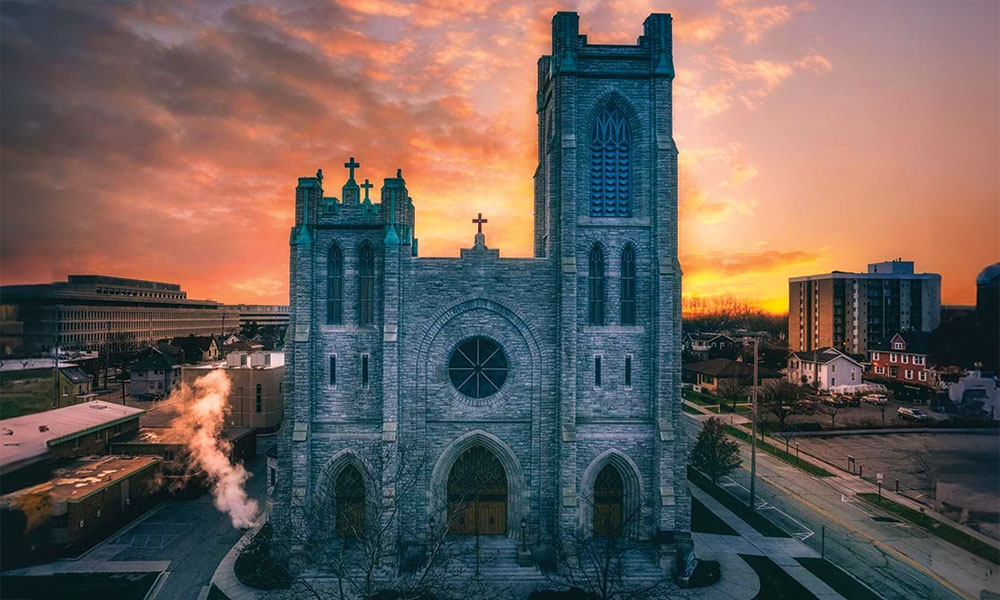
The Mother Church: St. Mary Cathedral
Friday, Dec. 8 marks the anniversary of the consecration of St. Mary Cathedral in Lansing. But what does the cathedral mean to the people of our diocese? FAITH’s David Kerr has been finding out in conversation with the rector of St. Mary, Father Karl Pung.
Friday, Dec. 8 marks the anniversary of the consecration of St. Mary Cathedral in Lansing. But what does the cathedral mean to the people of our diocese? FAITH’s David Kerr has been finding out in conversation with the rector of St. Mary, Father Karl Pung.
For over a century, the twin neo-gothic towers of St. Mary Cathedral have been a fixture of the Lansing skyline sitting adjacent, as they do, to the neoclassical dome of the state capitol. God and Caesar. Cheek by jowl. But while the capitol is, of necessity, a house divided, the cathedral betokens unity.
“The cathedral is a symbol of hope, it stands as an image of faith, it stands as a place that unites us to the greater Church,” says Father Karl Pung, who is now into his seventh year as Rector of Saint Mary Cathedral.
“The cathedral reminds us that we're not just individual parishes but part of a whole diocese, that we're not doing this alone, we're not meant to do this alone, but that we are connected to a much greater body.”
The construction of St.Mary Church began in 1911 under the guidance of the renowned Lansing architect, Edwyn A. Bowd. It replaced a prior parish church situated several blocks to the north. The new building was completed two years later and consecrated on Dec.8, 1913, the Solemnity of the Immaculate Conception of the Blessed Virgin Mary to whom the church is dedicated. It was upon the same date in 1937 that the new Diocese of Lansing was established and St. Mary Church became St. Mary Cathedral, housing the new bishop’s chair, or cathedra, in Latin.
“The heavenly patronage of Mary has been a beautiful constant across the decades,” says Father Pung, “she is our mom, she is part of our life and discernment, she is a member of our family, she helps lead us closer to Jesus, she’s part of the parish.”
Father Pung was ordained to the holy priesthood at Saint Mary in 1997. He observes three distinct populations who frequent the cathedral: the weekend congregation, “who keep the lights on”; the office workers and others, who come to weekday Mass; and, lastly, the whole diocese.
“As I say to people when they come here for the Chrism Mass on Holy Thursday: ‘welcome home!’” he says with an enthusiastic smile.
“In the Diocese of Lansing, we all have two parishes: our home parish and our diocesan parish, and that’s the cathedral. So, it's a home for everybody in the diocese in a particular way.”
This common sense of affiliation and affection means that St. Mary is often a place where “those who don’t belong anywhere else can find belonging here,” says Father Pung, explaining that his parish aspires to be “a place of refuge and discernment for Christians on the way.”
“The cathedral is a ‘well prayed in’ place; you can sit anywhere in this building and find yourself in a prayerful encounter with God. It is an easy place to pray, to encounter the Lord.”
While the church exterior has remained largely unchanged since its consecration, the cathedral interior saw the evolutionary embellishments of the early 20th century give way to a more revolutionary renovation in 1968 under the guidance of Bishop Alexander Zaleski.
Rather than dwell on the past, however, Father Pung says he is keen to look to the future. Last year he established a committee of parishioners to explore the possibility of a new 21st century renovation of the cathedral.
“The cathedral building has great bones. It has beautiful windows. There's a lot that can be done there to restore it to its original beauty and even, I think, increase the beauty,” says Father Pung.
“Whether that takes 20 years or we can get it done in four years, at present we are still trying to develop a common plan that reflects what the cathedral has been and, more importantly, what it could be.”
